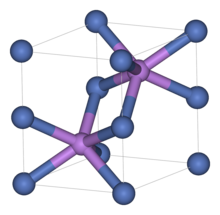 | |
| Names | |
|---|---|
| IUPAC name
Nickel(II) selenide
| |
| Other names
Nickel selenide
| |
| Identifiers | |
| ChemSpider | |
| ECHA InfoCard | 100.013.834 |
| EC Number |
|
PubChem CID
|
|
| UNII | |
CompTox Dashboard (EPA)
|
|
| Properties | |
| NiSe | |
| Molar mass | 137.65 g/mol |
| Appearance | black powder |
| Density | 7.2 g/cm3 |
| Insoluble | |
| Hazards | |
| Safety data sheet (SDS) | [] |
Except where otherwise noted, data are given for materials in their standard state (at 25 °C [77 °F], 100 kPa).
| |
Nickel selenide is the inorganic compound with the formula NiSe. As for many metal chalcogenides, the phase diagram for nickel(II) selenide is complicated. Two other selenides of nickel are known, NiSe2 with a pyrite structure, and Ni2Se3. Additionally, NiSe is usually nonstoichiometric and is often described with the formula Ni1−xSe, with 0 < x < 0.15.[1] This material is a semi-conducting solid, and can be obtained as in the form of a black fine powder, or silver if obtained in the form of larger crystals. Nickel(II) selenide is insoluble in all solvents, but can be degraded by strongly oxidizing acids.